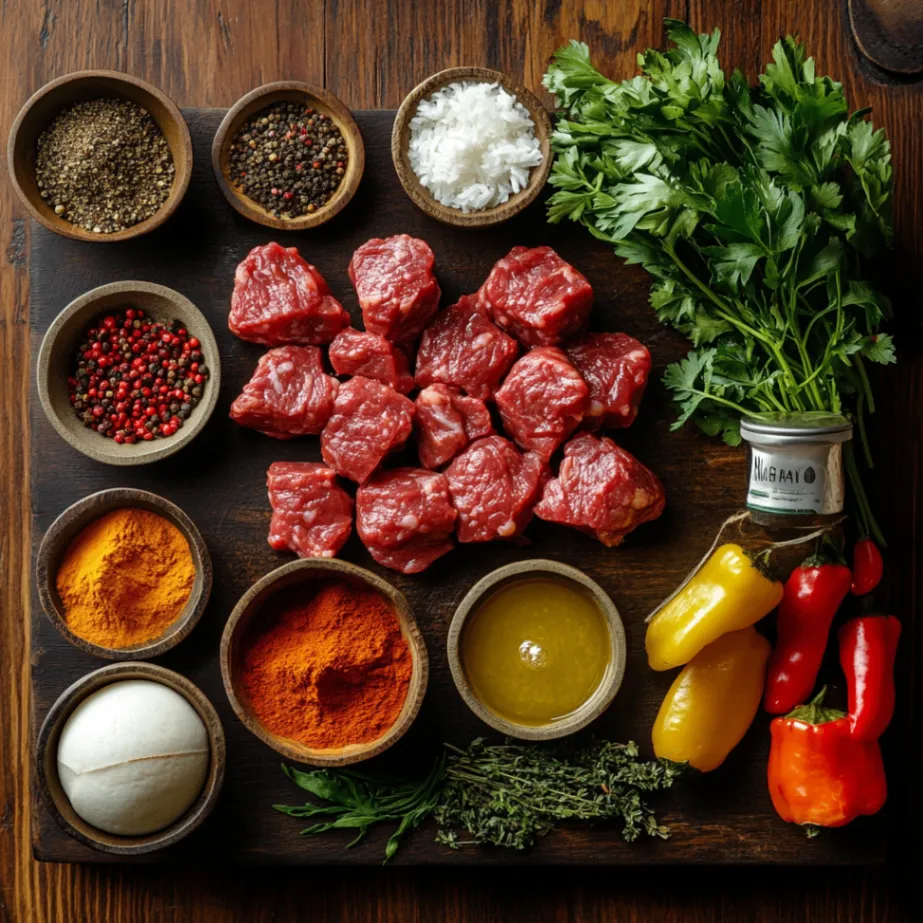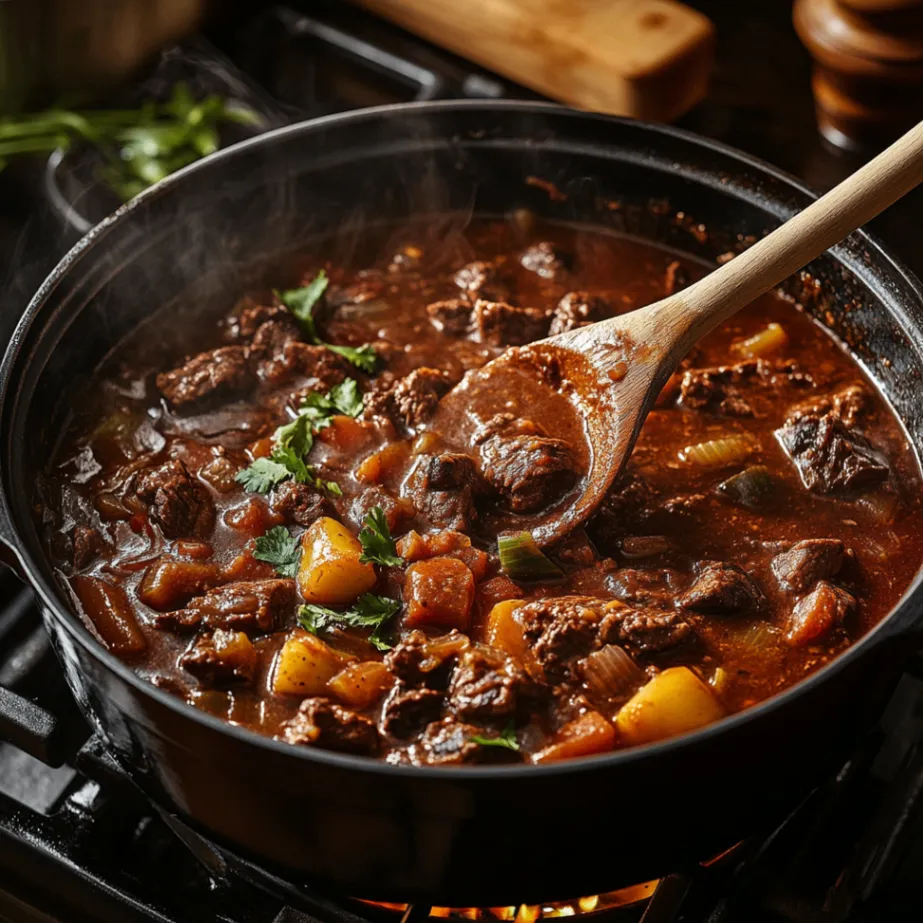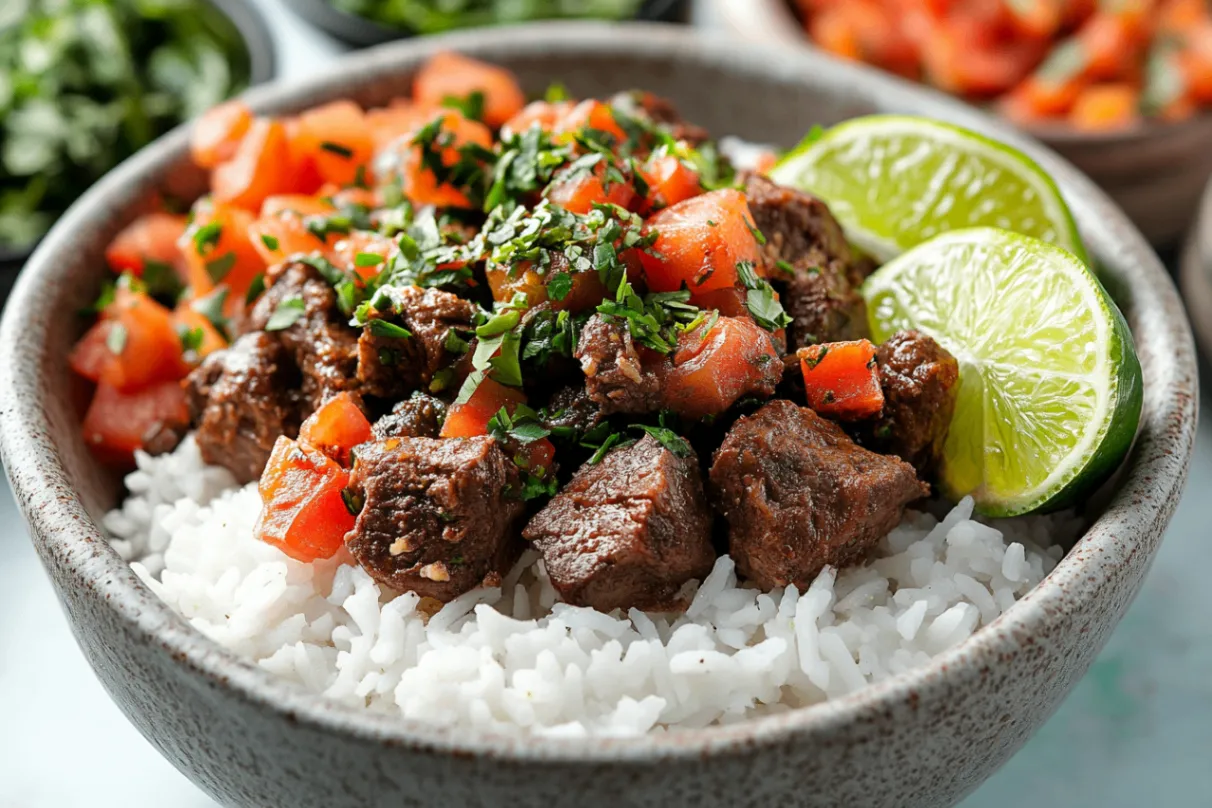Discover the authentic flavors of Brazilian Majoro with this traditional Majoro recipe – a hidden culinary gem that combines tender beef, aromatic spices, and the soul of Brazilian home cooking in every bite.
Table of Contents
Table of Contents
Uncovering Brazil’s Best-Kept Culinary Secret
Have you ever wondered what authentic Brazilian families cook when they want to celebrate something truly special? While most people think of feijoada or churrasco when Brazilian cuisine comes to mind, there’s a lesser-known treasure that deserves a place at your dinner table: Majoro Brasileiro Autêntico.
This remarkable dish represents the heart and soul of Brazilian Majoro home cooking, combining Portuguese colonial influences with indigenous ingredients and African cooking techniques. Majoro isn’t just a meal—it’s a cultural experience that tells the story of Brazil’s rich culinary heritage through layers of complex flavors and aromatic spices.
What makes Majoro so extraordinary is its perfect balance of tender, slow-cooked beef with a vibrant sauce that dances between sweet, savory, and slightly spicy notes. The dish gets its distinctive character from a unique blend of Brazilian Majoro spices, including the often-overlooked pimenta-de-cheiro and the earthy depth of cominho brasileiro.
In this comprehensive guide, you’ll learn not only how to prepare authentic Brazilian Majoro but also the cultural significance behind each ingredient, professional cooking techniques that ensure perfect results every time, and insider tips passed down through generations of Brazilian Majoro home cooks.
The Cultural Heritage Behind Brazilian Majoro
Origins and Regional Variations
Brazilian Majoro originated in the northeastern states of Brazil, particularly in Bahia and Pernambuco, where African culinary traditions merged with Portuguese colonial cooking methods. The name “Majoro” is believed to derive from the Yoruba word “màjọ̀rọ̀,” meaning “to cook with care and attention.”
Different regions of Brazil have developed their own interpretations of Majoro:
Bahian Style: Features dendê oil and coconut milk, reflecting strong African influences Paulista Version: Incorporates coffee grounds for an earthy depth Mineiro Tradition: Uses locally-sourced cheese and fresh herbs Northeastern Classic: The version we’re sharing today, known for its balanced spice profile
Why Majoro Deserves a Place in Your Recipe Collection
Unlike many Brazilian Majoro dishes that require hard-to-find ingredients, Majoro can be recreated in any kitchen worldwide while maintaining its authentic character. The dish offers incredible versatility—it’s equally impressive for Sunday family dinners and elegant dinner parties. Plus, like many Brazilian Majoro stews, Majoro actually improves in flavor when prepared a day ahead, making it perfect for meal planning.

Ingredients
Tried this recipe?
Let us know how it was!
Essential Ingredients for Authentic Brazilian Majoro
Primary Ingredients
For the Beef:
- 3 pounds (1.4 kg) beef chuck roast, cut into 2-inch cubes
- 2 pounds (900g) beef short ribs, cut into 3-inch pieces
- 1 pound (450g) Portuguese linguiça sausage, sliced diagonally
For the Sofrito Base:
- 4 large yellow onions, finely diced
- 8 cloves garlic, minced
- 2 large red bell peppers, diced
- 3 medium tomatoes, peeled and chopped
- 1 bunch fresh cilantro, chopped
- ½ cup fresh parsley, chopped
Brazilian Spice Blend:
- 2 tablespoons ground cumin (cominho)
- 1 tablespoon sweet paprika
- 1 teaspoon smoked paprika
- 2 teaspoons dried oregano
- 1 teaspoon ground coriander
- ½ teaspoon ground allspice
- ¼ teaspoon ground cloves
- 2 bay leaves
- 1 teaspoon red pepper flakes (or to taste)
Liquid Components:
- 4 cups beef stock (preferably homemade)
- 2 cups dry red wine (Brazilian Cabernet Sauvignon preferred)
- ¼ cup cachaça (Brazilian sugar cane liquor)
- 2 tablespoons tomato paste
- 1 can (14 oz) coconut milk
- 2 tablespoons lime juice
Vegetables and Accompaniments:
- 2 large carrots, cut into 1-inch pieces
- 2 large potatoes, cubed
- 1 cup green olives, pitted
- 2 tablespoons capers
- 3 tablespoons palm oil (dendê) or olive oil
- Salt and black pepper to taste
Ingredient Substitutions and Sourcing Tips
Hard-to-Find Ingredients:
- Cachaça: Substitute with white rum or vodka if unavailable
- Dendê Oil: Extra virgin olive oil works, though flavor will differ slightly
- Portuguese Linguiça: Spanish chorizo or Italian sausage can substitute
- Brazilian Cumin: Regular cumin works, but toast whole seeds and grind for best flavor
Quality Considerations: Always choose grass-fed beef when possible, as it provides better flavor and texture for slow-cooking methods. Look for well-marbled chuck roast and meaty short ribs for optimal results.
Step-by-Step Preparation Method
Phase 1: Preparing the Meat (30 minutes)
- Season the Beef: Pat all beef pieces completely dry with paper towels. This crucial step ensures proper browning. Season generously with salt and black pepper, then dust lightly with 1 tablespoon of the cumin blend. Let rest at room temperature for 20 minutes.
- Brown the Meat: Heat 2 tablespoons of palm oil in a large, heavy-bottomed Dutch oven over medium-high heat. Working in batches to avoid overcrowding, brown beef cubes on all sides, approximately 3-4 minutes per side. Transfer browned beef to a large plate and set aside.
- Cook the Sausage: In the same pot, brown the linguiça sausage pieces until they develop a nice crust, about 5 minutes. Remove and set aside with the beef.
Phase 2: Building the Sofrito Base (25 minutes)
- Create the Sofrito: Reduce heat to medium and add diced onions to the same pot with the rendered fat. Cook, stirring occasionally, until onions become translucent and lightly caramelized, about 8-10 minutes.
- Add Aromatics: Add minced garlic and cook for 1 minute until fragrant. Add diced bell peppers and cook for another 5 minutes until they begin to soften.
- Incorporate Tomatoes: Add chopped tomatoes and tomato paste. Cook, stirring frequently, until tomatoes break down and the mixture becomes paste-like, approximately 8-10 minutes.
- Bloom the Spices: Add all remaining spices (cumin, paprikas, oregano, coriander, allspice, cloves, bay leaves, and red pepper flakes). Stir constantly for 1-2 minutes until the spices become fragrant and well incorporated.
Phase 3: Deglazing and Building Flavor (15 minutes)
- Deglaze with Cachaça: Remove the pot from heat and carefully add cachaça. Return to heat and scrape up any browned bits from the bottom of the pot using a wooden spoon.
- Add Wine: Pour in red wine and bring to a simmer. Let it reduce by half, approximately 5-7 minutes. This concentrates the flavors and cooks off the alcohol.
- Return the Meat: Add browned beef and sausage back to the pot, along with any accumulated juices.
Phase 4: Slow Cooking Process (2.5-3 hours)
- Add Stock: Pour in beef stock until meat is just covered. If needed, add hot water to reach proper level. Bring to a gentle simmer.
- Initial Braising: Cover pot with a tight-fitting lid and transfer to a preheated 325°F (163°C) oven. Cook for 1.5 hours without opening the lid.
- Add Vegetables: Remove pot from oven and carefully add carrots and potatoes. If liquid level has reduced significantly, add hot stock or water to maintain coverage.
- Continue Cooking: Return to oven for another 45-60 minutes, until beef is fork-tender and vegetables are cooked through.
Phase 5: Final Flavor Development (20 minutes)
- Finish on Stovetop: Remove pot from oven and place on stovetop over medium-low heat. Stir in coconut milk, green olives, and capers.
- Final Seasoning: Taste and adjust seasoning with salt, pepper, and lime juice. The dish should have a rich, complex flavor with balanced acidity.
- Rest and Serve: Let the Majoro rest for 10 minutes before serving. Garnish with fresh cilantro and parsley.

Professional Cooking Tips and Techniques
Temperature Control Mastery
The key to perfect Majoro lies in maintaining consistent, gentle heat throughout the cooking process. Your oven temperature should remain steady at 325°F (163°C)—too high and the meat will become tough, too low and it won’t develop proper texture.
Liquid Level Management
Monitor liquid levels carefully during cooking. The meat should remain barely covered throughout the braising process. If liquid reduces too much, add hot stock rather than cold water to maintain temperature consistency.
Browning Technique
Proper browning is crucial for developing deep flavors. Never crowd the pan when browning meat—this causes steaming rather than browning. Pat meat completely dry and ensure your oil is hot before adding meat pieces.
Make-Ahead Strategy
Majoro is one of those magical dishes that tastes even better the next day. The flavors meld and intensify overnight, making it perfect for entertaining. Prepare the dish completely, cool to room temperature, then refrigerate. Reheat gently on stovetop, adding a splash of stock if needed.
Spice Grinding Tips
For the most authentic flavor, buy whole spices and grind them yourself. Toast whole cumin seeds, coriander, and allspice berries in a dry pan for 2-3 minutes before grinding. This extra step dramatically improves the dish’s aromatic profile.
Traditional Serving Suggestions and Accompaniments
Classic Brazilian Sides
Arroz Branco (Brazilian White Rice): The traditional accompaniment that absorbs the rich Majoro sauce perfectly. Cook with a bay leaf and a clove of garlic for authentic flavor.
Farofa de Mandioca: Toasted cassava flour mixture with onions, garlic, and herbs. This provides textural contrast and helps soak up the delicious sauce.
Couve Refogada: Brazilian-style collard greens sautéed with garlic and bacon. The slight bitterness balances the rich meat dish beautifully.
Pão de Açúcar: Traditional Brazilian bread rolls, perfect for sopping up every drop of sauce.
Modern Presentation Ideas
For contemporary dinner parties, consider serving Majoro over creamy polenta or with garlic mashed potatoes. The dish also works beautifully over wide egg noodles or with crusty artisanal bread.
Wine Pairing Recommendations
The robust flavors of Majoro pair excellently with full-bodied red wines. Consider Brazilian Majoro Cabernet Sauvignon, Argentine Malbec, or Portuguese Douro reds. For white wine lovers, a rich Chardonnay or Viognier can complement the coconut milk elements.
Nutritional Benefits and Dietary Considerations
Nutritional Profile
Majoro provides excellent nutritional value, combining high-quality protein from grass-fed beef with vitamins and minerals from the vegetable components. One serving (approximately 8 oz) contains:
- Protein: 35-40 grams
- Iron: 25% daily value
- Vitamin B12: 180% daily value
- Zinc: 35% daily value
- Potassium: 800mg
Dietary Adaptations
Gluten-Free: Naturally gluten-free when served with rice instead of bread Dairy-Free: Uses coconut milk instead of dairy products Low-Carb Option: Serve over cauliflower rice or zucchini noodles Paleo-Friendly: Omit potatoes and serve with additional vegetables
Storage and Reheating Instructions
Proper Storage Methods
Cool Majoro completely before refrigerating. Store in airtight containers for up to 4 days in the refrigerator or up to 3 months in the freezer. The stew actually improves in flavor after 24 hours in the refrigerator.
Reheating Techniques
Reheat gently on the stovetop over medium-low heat, stirring occasionally. Add a splash of beef stock if the sauce has thickened too much. Avoid microwave reheating when possible, as it can make the meat tough.
Troubleshooting Common Issues
Problem: Tough Meat
Solution: Continue cooking longer at low temperature. Tough meat indicates insufficient cooking time or too high temperature.
Problem: Sauce Too Thin
Solution: Remove lid and simmer on stovetop to reduce, or mix 2 tablespoons cornstarch with cold water and stir in gradually.
Problem: Overly Salty
Solution: Add diced potatoes and cook until tender, then remove. Potatoes absorb excess salt naturally.
Problem: Lacking Depth
Solution: Add 1-2 tablespoons of dark brown sugar and a splash of balsamic vinegar to enhance complexity.
 DINNER
DINNER  LUNCH
LUNCH  Desserts
Desserts  BREAKFAST
BREAKFAST For more amazing recipes, be sure to check out our other sections to explore a variety of ideas that will enrich your cooking experience. Each section offers its own unique flavors to ensure a delightful culinary journey:
Easy and Quick Recipes: A collection of dishes that guarantee delicious meals with minimal effort and time.
Healthy Recipes: Discover healthy and delicious options that fit your lifestyle.
Desserts: A diverse selection of sweets that will add a special touch of sweetness to your table.
Lunch Recipes: Tasty lunch ideas that you can easily prepare to delight your family.
Dinner Recipes: Delicious and easy-to-make recipes that will make your dinner a memorable occasion.
Frequently Asked Questions
What makes Brazilian Majoro different from other beef stews?
Brazilian Majoro distinguishes itself through its unique combination of Portuguese, African, and indigenous Brazilian Majoro nfluences. The use of cachaça, coconut milk, dendê oil, and specific Brazilian Majoro spice combinations creates a flavor profile that’s distinctly different from European or American beef stews. The inclusion of linguiça sausage and the particular vegetable combination also set it apart.
Can I make Majoro in a slow cooker or Instant Pot?
Yes, both adaptations work well. For slow cooker: brown meat and sauté vegetables first, then transfer everything to slow cooker and cook on low for 6-8 hours. For Instant Pot: use sauté function for browning, then pressure cook for 45 minutes with natural release. However, the traditional oven method provides the best texture and flavor development.
How spicy is traditional Majoro?
Authentic Majoro has a mild to moderate heat level. The spiciness comes primarily from red pepper flakes and paprika rather than hot peppers. You can easily adjust the heat level by increasing or decreasing the red pepper flakes according to your preference.
What’s the best cut of beef for Majoro?
Chuck roast and short ribs are ideal because they contain enough connective tissue to become tender and flavorful during long, slow cooking. Avoid lean cuts like sirloin or tenderloin, as they’ll become dry and tough with extended cooking.
Can I prepare Majoro ahead of time for entertaining?
Absolutely! Majoro is perfect for make-ahead entertaining. Prepare the dish completely 1-2 days before serving, then reheat gently on the stovetop. The flavors actually improve with time, making this an ideal dinner party dish.
Is there a vegetarian version of Majoro?
While traditional Majoro is meat-based, you can create a vegetarian version using mushrooms (portobello, cremini, and shiitake work well), eggplant, and additional root vegetables. Use vegetable stock and increase the umami flavors with soy sauce or mushroom powder.
How do I know when the meat is properly cooked?
The beef should be fork-tender—easily pierced and shredded with a fork. If there’s any resistance when piercing with a fork, continue cooking. Properly cooked Majoro meat should practically fall apart when stirred.
What if I can’t find cachaça?
White rum is the best substitute for cachaça, as both are sugar cane-based spirits. Vodka works as a secondary option. In a pinch, you can omit the cachaça entirely and add an extra tablespoon of lime juice for brightness.

Conclusion: Bringing Brazil’s Culinary Heritage to Your Table
Brazilian Majoro represents more than just a delicious meal—it’s a celebration of Brazil’s rich cultural tapestry and culinary evolution. This dish embodies the warmth and hospitality that Brazilian Majoro cuisine is famous for, bringing families and friends together around the dinner table.
By mastering this authentic Brazilian Majoro recipe, you’re not only adding an impressive dish to your culinary repertoire but also connecting with generations of Brazilian Majoro home cooks who have perfected these flavors over centuries. The combination of tender, slow-cooked beef with aromatic spices and traditional Brazilian Majoro ingredients creates a dining experience that transports you straight to the heart of Brazil.
Whether you’re planning a special family dinner, entertaining guests, or simply wanting to explore authentic South American cuisine, this Brazilian Majoro recipe delivers exceptional results every time. The make-ahead friendly nature of the Brazilian Majoro dish makes it perfect for busy home cooks, while its sophisticated flavor profile impresses even the most discerning palates.
Remember that great cooking is about more than following recipes—it’s about understanding ingredients, respecting traditions, and adding your own touch while honoring the Brazilian Majoro culinary heritage. As you prepare this Brazilian Majoro, take time to appreciate the complex layers of flavor that develop through patient, careful cooking.
The beauty of Brazilian Majoro lies in its ability to bring people together, creating lasting memories over shared meals and meaningful conversations. In Brazil, food is love, and this traditional Brazilian Majoro allows you to share that love with everyone at your table.
Bom apetite! Enjoy your culinary journey to Brazil, one delicious Brazilian Majoro bite at a time.
